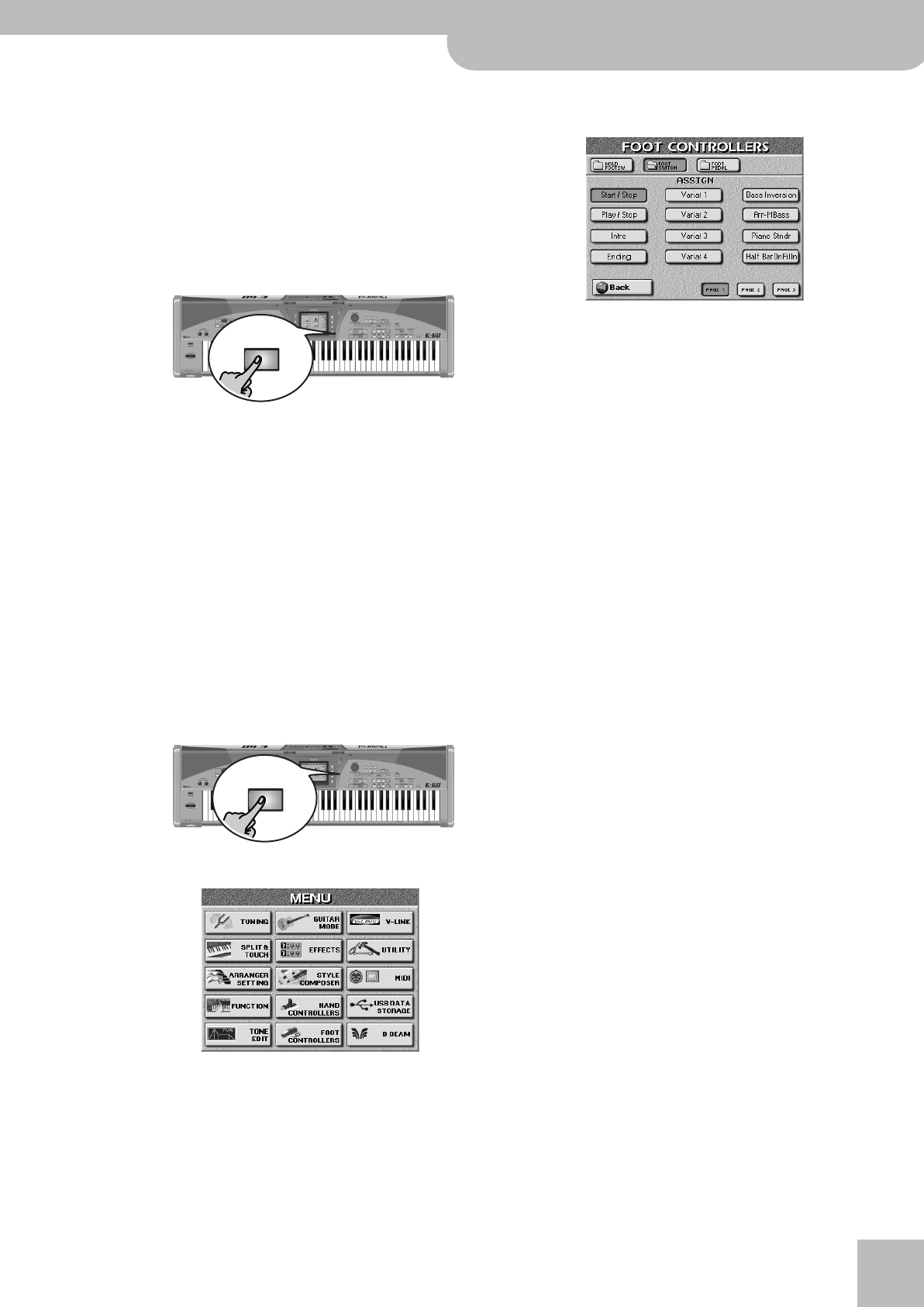
Using optional footswitches
E-60/E-50 Music Workstation
r
55
“Auto” means that the part in question only responds
to Hold messages if it is assigned to the right half or
the entire keyboard. “On” means that the part in
question always responds to Hold messages, even if it
is assigned to the left half of the keyboard. “Off”,
finally, means that the part does not respond to Hold
messages.
(5) If necessary, press another PART field and change
the HOLD ASSIGN setting for the selected part.
(6) Press the [EXIT] button to return to the main page.
Foot Switch
‰ Important remark: The settings below are only used
if you connect an optional DP-2, DP-6 or BOSS FS-5U
footswitch to the FOOTSWITCH/EXPRESSION socket. If
you choose to connect an expression pedal instead, see
“Expression (Foot Pedal)” on p. 56.
A second footswitch (in addition to the one connected
to the HOLD socket) can be used to perform various
functions. If you do not change the factory setting, this
footswitch allows you to start and stop Arranger play-
back (“Start/Stop”).
Note the Soft and Sostenuto options as well as the pos-
sibility to select one of several Hold functions. The foot-
switch can only perform one function at a time,
though.
(1) Press the [MENU] button.
The display changes to:
(2) Press the [FOOT¥CONTROLLER] field, followed by
the [FOOT¥SWITCH] field.
(3) Press the field that corresponds to the function
you wish to assign to the footswitch.
If necessary, use the [PAGE¥1]~[PAGE¥3] fields to go
to another page.
● Start/Stop—Starts and stops Arranger playback. Same
function as the [START÷STOP] button.
● Play/Stop—Starts and stops the Recorder and 16-track
sequencer. Same function as the [PLAY÷STOP¥®÷ª] but-
ton.
● Intro—Selects the Intro of the current Variation level
(1~4) during Arranger playback. Same function as
[INTRO].
● Ending—Selects the Ending of the current Variation
level (1~4) during Arranger playback.
● Variat 1~4—The footswitch can be used to switch to the
VARIATION level you select here. That Music Style pat-
tern is used from the next downbeat onward.
● Bass Inversion—Same function as the [BASS¥INVERS]
button (page 61).
● Arr/M.Bass—Allows you to set the Arranger Chord
parameter to “Off” (chord recognition plus ABS recogni-
tion off, see p. 66) and, at the same time, activate the
KBD MODE [SPLIT] button and the MBS part – and vice
versa.
● Piano/Standard—You can alternate between Standard
and Piano Style Arranger Chord modes. When the
former is selected, the chord recognition area (page 67)
is automatically set to “LEFT”. When you switch to Piano
Style, the chord recognition area is automatically set to
“WHOLE”. Furthermore, the KBD MODE [WHOLE] button
is switched on and the Upper 1 part is activated (if it was
off).
● Half Bar on Fill In—The footswitch allows you to switch
the Half Bar function on and off. Certain pop songs in 4/
4 contain bars that only last two beats. The usual place
for such a bar is between the first and the second verse.
This does not change Style playback right away. Pressing
the footswitch does not change Style playback right
away. Only when a Fill-In or another MAIN division starts
will the Half Bar function be activated and play half the
number of beats of the accompaniment pattern you
selected.
● Arranger Hold—Allows you to switch the Arranger Hold
function on and off. See p. 67.
● Dynamic Arranger—Allows you to switch the Dynamic
Arranger function on and off. See page 67 for details.
● Rotary Slow/Fast—Allows you to select the slow or fast
speed of the Rotary effect. This only works, if the Rotary
effect is currently assigned to the Multi-FX.
EXIT
MENU
E-60_50_OM_UK.book Page 55 Thursday, June 22, 2006 10:06 AM


















